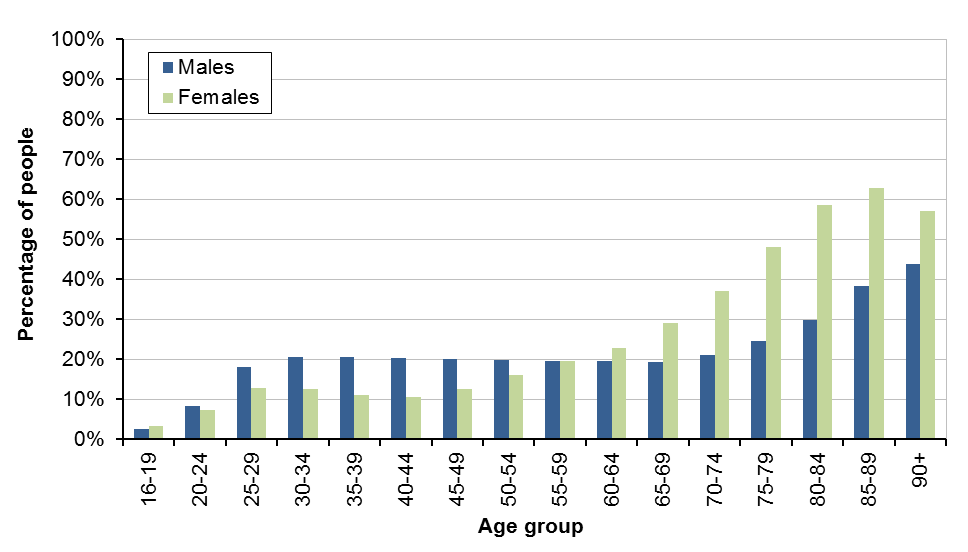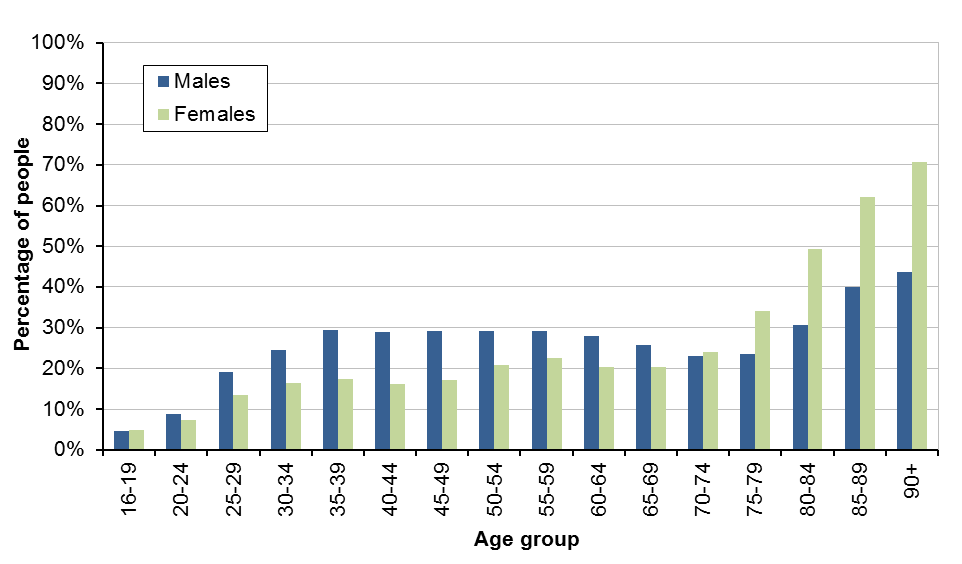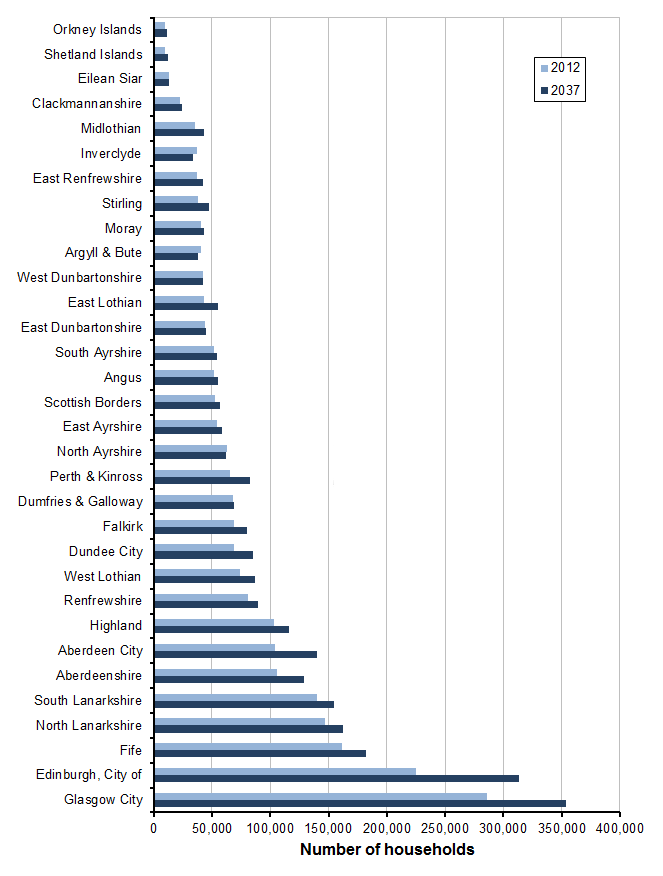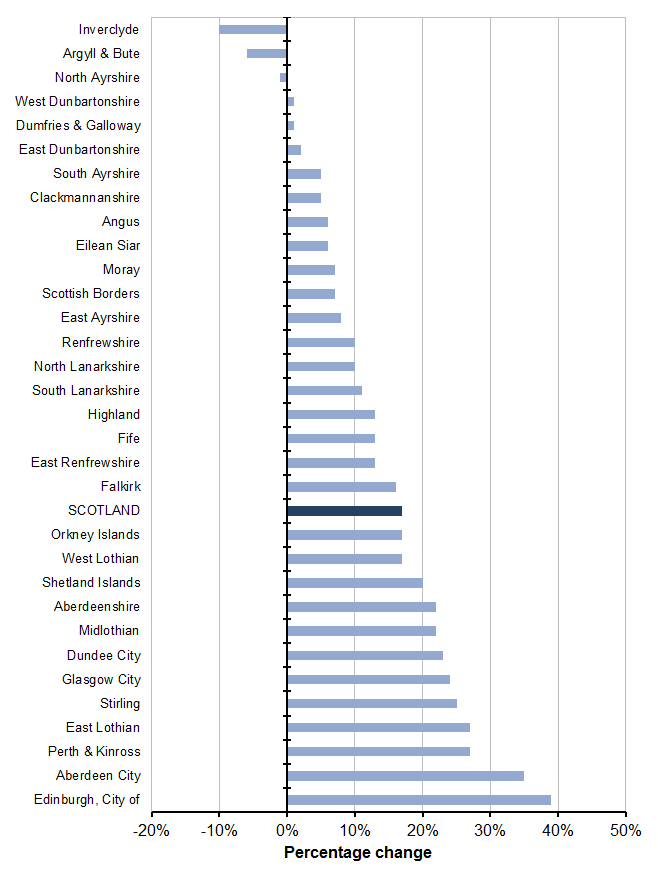2.1.1 The number of households in Scotland is projected to increase from 2.39 million to 2.78 million between 2012 and 2037, an increase of 17 per cent. The projected yearly increase in the number of households is 15,820. The rate of the increase is lower in the later years of the projections period.
2.1.2 The household projections are affected by the projected trends in the Scottish population. The population is projected to increase by nine per cent between 2012 and 2037, with average annual increases that are greater at the beginning of the projection period than at the end. This rise in population explains some of the increase in household numbers over the projection period.
2.1.3 However, the household projections increase by a larger percentage than the population projections, as shown in Figure 2. The larger change in the household projections is a result of more people living alone or in smaller households (Section 2.2). Scotland’s population is ageing, with the number of people aged 65 or over increasing much faster than the number of children and younger adults. This has an impact on household structure as children tend to live in larger households and older people in smaller ones.

2.1.4 The average household size is projected to decrease from 2.18 people in 2012 to 2.03 people in 2037, continuing the long-running decline in average household size.
2.1.5 In 1961, the average household size was over three people, and it has been falling over time as more people live in smaller households and fewer people live in large households. However, the rate of change has been slowing down in recent decades. Figure 3 shows how the one person households have gone from being the least common household size in the 1961 Census to the most common in the 2011 Census.

2.1.6 The economic downturn which began in 2008 also appears to have had an effect on household size; estimates of average household size between 2001 and 2011 show that it has been roughly constant since 20081. Increases in unemployment, reductions in the number of new homes being built and a constrained mortgage market2, amongst other factors, have contributed to a slower rate of increase in household numbers since 2008 than seen earlier in the decade. The number of young adults aged 20-34 living with their parents (rather than living alone or in couples) has been rising, which is likely to have contributed to the changes in household size over this period.
2.1.7 These results can be found in Table 1.
2.2.1 As described above, the decline in average household size in Scotland results from more people living alone or in smaller households. Table 2 and Figure 4 show the projected number of households of each type in 2012 and 2037. The largest projected increase (in number and percentage terms) is in households containing one adult only. The numbers of households containing two adults only and one adult with children are also projected to rise. In contrast, numbers of larger households are projected to fall.

2.2.2 The number of households broken down by the age group of the head of household is shown in Table 3 and Figure 5. The largest increases are for those headed by someone aged 65 or over. By 2037, there are projected to be 966,600 households headed by someone in this age group, an increase of 54 per cent from 2012. This is mainly because Scotland’s population is ageing. The latest population projections show that the number of people aged 65 or over will increase by 59 per cent by 2037. The increases in household numbers are even more striking when focussing on those aged 85 or over. The number of households headed by someone in this age group is projected to more than double from 77,400 to just over 200,000.
2.2.3 The number of households headed by someone under 65 is also projected to increase, but much more slowly than households headed by older people. By 2037, numbers of such households are projected to increase by just three per cent. Unlike those aged 65 or over, the number of people aged 16 to 64 is projected to decrease in the population projections. Therefore the increase in households headed by someone under 65 is caused by people becoming more likely to live in smaller households than they have in the past.
2.2.4 The only reduction in household numbers is for those aged 55-64 where there is a projected fall of less than one per cent, from 400,900 to 398,100.

2.2.5 Projected household numbers for Scotland, by household type and age of head
of household can be found in Table 4 and
Figure 6.

2.2.6 In 2012, 19 per cent of the population aged 16 or over lived alone and this is projected to rise to 24 per cent by 2037. The figures in Table 5 show that people are more likely to live alone as they become older, with 56 per cent of people aged over 85 projected to be living alone in 2037, up slightly from 54 per cent in 2012. The percentages vary according to gender and age, as illustrated in Figures 7a and 7b. In 2037, in most age groups up to 70 years old, men are more likely to live alone than women. From the age of 70 onwards, however, women are more likely to live alone, and this likelihood increases with age. This pattern reflects women’s greater life expectancy, and the tendency of women to marry men who are older than them, which means that women are more likely to out-live their partners.
2.2.7 The gap between the average life expectancy of men and women in Scotland is decreasing3. This means that the number of older men is projected to increase more rapidly than the number of older women, which contributes to the projected increase in the total number of men living alone. In 2012, 96,400 men aged 65 or over were living alone; this is projected to nearly double (93 per cent increase), to 186,100 in 2037. This compares to an increase of 33 per cent in number of women aged 65 or over living alone, to 302,100.
2.2.8 The number of men aged 85 or over living alone is projected to more than treble from 13,800 to 46,100, a 234 per cent increase, compared to a 139 per cent increase for women. Despite the sharper rise in the number of men living alone there will still be many more women aged 85 or over living alone. In 2037, 108,000 women aged 85 or over (66 per cent of women in this age group) are projected to live alone compared to 46,100 men (42 per cent of men in this age group).
2.2.9 The substantial projected increase in the number of older households, and particularly the increase in older people living alone, has implications for services, and policies, aimed at supporting older people.


2.2.10 The number of two adult households is projected to rise by almost a fifth (19 per cent) from 731,300 to 869,900. However, the percentage of all households which contain just two adults remains stable at just under a third (31 per cent). The increase in numbers of two adult households is mainly down to large increases in those headed by someone aged 65 or over. This is a result of projected increases in the population in this age group, as well as the narrowing of the gap between male and female life expectancy. The number of two adult households headed by someone aged 65 or over is projected to increase by 59 per cent from 262,500 in 2012 to 418,500 in 2037. The number of two adult households headed by someone aged 85 or over more than doubles over the same period, to over 40,000. By 2037 almost half (48 per cent) of two adult households will be headed by someone aged 65 or over, compared with 35 per cent in 2012.
2.2.11 In contrast, the number of two adult households headed by someone aged 45-64 is projected to fall by around 17 per cent (a reduction of 50,100 households). The number of such households headed by someone aged under 45 is projected to increase by 18 per cent.
2.2.12 Meanwhile, the number of households with three or more adults is projected to decline for those aged between 35 and 70, but increase for younger and older age groups. In 2012 nine per cent of all households were this type, this falls to six per cent in 2037.
2.2.13 In 2012, six per cent of all households consisted of one adult living with one or more children. Although they are projected to increase in numbers by 27 per cent by 2037, their share of all households remains roughly constant. The number of households of this type is projected to rise for all ages of head of household, with the majority of the increase being among those aged between 35 and 50.
2.2.14 In 2012, 19 per cent of all households contained two or more adults with children, a figure that is projected to fall to 14 per cent by 2037 (a reduction of 11 per cent in household numbers). There are reductions in the numbers headed by someone under 50, but increases in all older age groups.
2.3.1 Household projections by household type and age group for all 32 Council areas can be found in the detailed Council area tables on the National Records of Scotland (NRS) website. It should be noted that projections for areas with small populations tend to be less reliable than those for areas with larger populations.
2.3.2 The total number of households, by Council area, is presented in Table 6. The number of households in almost every Council area is projected to increase over the projection period. Figure 8a shows the projected number of households in each Council area in 2012 and 2037.
2.3.3 Figure 8b shows the projected percentage change in the number of households between 2012 and 2037. This information is also presented as a map in Figure 9. The largest projected percentage increases between 2012 and 2037 are in City of Edinburgh (39 per cent), Aberdeen City (35 per cent), Perth and Kinross (27 per cent) and East Lothian (27 per cent). In contrast, three Council areas are projected to have a fall in household numbers. These Councils areas are Inverclyde (10 per cent decrease), Argyll and Bute (six per cent) and North Ayrshire (one per cent).
2.3.4 The changes in household numbers can be compared to the changes in the projected population for each Council area, between 2012 and 20374 . The projected population changes range from a fall of 19 per cent for Inverclyde to increases of 28 per cent for Aberdeen City and City of Edinburgh. Although 12 Council areas are projected to have a decline in population over the 25 years, only three are also projected to experience a decline in household numbers. This difference is a result of people becoming increasingly likely to live in smaller households, as discussed in Section 2.2.
2.3.5 The projected average household size for each Council area can be seen in Table 7. The areas with the largest projected average household size in 2037 are Aberdeenshire (2.29) and Midlothian (2.25). The areas with the smallest average household size are Eilean Siar (1.78), Glasgow City (1.88) and Inverclyde (1.89). Figure 10 is a map showing the average household size for each Council area in 2037 and shows that the areas with the largest average household sizes (over 2.15) tend to be adjacent to the cities which have low average household sizes. This is related to the different population and household structure of these areas, as young people move to the cities for work or study, and then people are more likely to move to surrounding Council areas as their families grow, for example as people form couples and have children. The average household size is projected to be less than two people for 13 of the 32 Council areas by 2037.




2.4.1 Table 8 shows the percentage of households in each household type for each Council area in 2012 and in 2037.
2.4.2 In every Council area there is a projected increase in the number of people living alone between 2012 and 2037, ranging from a 10 per cent increase in Argyll and Bute to a 56 per cent increase in City of Edinburgh. The map in Figure 11 shows the projected percentage of households which contain just one adult, in each Council area in 2037.
2.4.3 By 2037, nearly half of the households in Glasgow City (49 per cent) are projected to be single adult households, compared to the Scottish figure of 41 per cent. The lowest percentage of single adult households is found in Aberdeenshire, 32 per cent. In general, the figures are highest in the cities and in the west of the country.
2.4.4 There is a projected increase in two adult households between 2012 and 2037 in all but three Council areas. The largest increase is in City of Edinburgh (37 per cent). The Council areas with a projected decrease are Inverclyde (10 per cent decrease), Argyll and Bute (five per cent) and Dumfries and Galloway (0.4 per cent). The proportion of households consisting of two adults but no children in 2037 is projected to vary from 25 per cent in Glasgow City to 37 per cent in the Scottish Borders, compared to a Scottish figure of 31 per cent
2.4.5 In contrast, there are projected reductions in three or more adult households in the majority of Council areas. North Ayrshire is projected to experience the greatest percentage decrease at 39 per cent. The only Council areas with projected increases are City of Edinburgh (seven per cent) and Glasgow City (four per cent). The percentage of households of this type in each Council area ranges from four per cent (Scottish Borders) to nine per cent (East Dunbartonshire) in 2037.
2.4.6 The number of households containing children is projected to fall by just under 2 per cent by 2037 in Scotland as a whole. The number of such households containing just one adult is projected to increase by 27 per cent by 2037 whereas the number containing two or more adults is to fall by 11 per cent.
2.4.7 Nearly all Council areas are projected to see an increase in the number of households consisting of one adult with one or more children, between 2012 and 2037. The highest percentage increase occurs in Perth and Kinross, where the number of households is projected to rise by 72 per cent (from 3,380 in to 5,830). Inverclyde is the only Council area with a projected reduction, a fall of 14 per cent. West Lothian is projected to have the highest proportion of households of this type in 2037 (10 per cent of all households), and Aberdeen City the smallest (four per cent of all households).
2.4.8 The number of households containing two or more adults with children is projected to decrease between 2012 and 2037 in three quarters of Council areas. The largest percentage decrease is found in Inverclyde (45 per cent fall) while the largest percentage increase is found in Aberdeen City (28 per cent increase). Eilean Siar is projected to have the smallest proportion of this type of household (10 per cent) whilst Aberdeenshire is projected to have the highest (21 per cent).
2.4.9 Figure 12 shows the projected percentage of households with children (regardless of the number of adults) in each Council area in 2037. In general, it is the Council areas which are reasonably close to the main cities which have the highest percentages of households with children. The figures are lower in the cities themselves, and in the more remote rural areas and island Council areas. East Lothian, West Lothian, Midlothian and East Renfrewshire have the highest proportions of households containing children, at around 27 per cent of all households in each. Eilean Siar has the smallest proportion, 15 per cent.
2.5.1 The percentages of households headed by different ages of head of household are shown in Table 14, for 2012 and 2037. The numbers of households in each age group, by Council area, can be seen in Tables 15 to 19.
2.5.2 Just over half of Council areas are projected to see reductions in the numbers of households headed by adults aged under 44 (18 Council areas). For the majority of Council areas (28) there is a projected decrease in the number of households headed by someone aged 45 to 59, with only the city Council areas (Aberdeen City, Dundee City, the City of Edinburgh and Glasgow City) having increases in this age group. In contrast, the number of households headed by someone aged 60-74 is projected to rise in most Council areas (27).
2.5.3 The age group with the largest increase in household numbers is where the head of the household is aged 75 or over. Every Council area is projected to see an increase in this age group. The smallest percentage increases are in Dundee City (39 per cent) and Glasgow City (44 per cent). In contrast, the numbers of such households are projected to more than double in Aberdeenshire (107 per cent increase), Midlothian (107 per cent), Highland (108 per cent), Orkney Islands (118 per cent), Clackmannanshire (121 per cent), Shetland Islands (125 per cent) and West Lothian (133 per cent). By 2037 around one in five (20 per cent) of households in Scotland are projected to be headed by someone aged 75 or over, compared with 13 per cent in 2012. East Dunbartonshire has the highest proportion of such households in 2037 (32 per cent) and Glasgow City the lowest (12 per cent).
2.5.4 Figure 13 shows the projected percentage of households headed by someone aged 60 or over in 2037. Nine Council areas are projected to have over half of their households headed by someone in this age group by 2037. Eilean Siar is projected to have the highest proportion of such households in 2037 (58 per cent), whereas the lowest proportions are in Aberdeen City, Dundee City, the City of Edinburgh and Glasgow City (29 to 31 per cent).



Footnotes